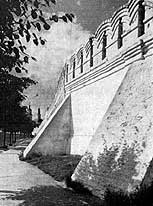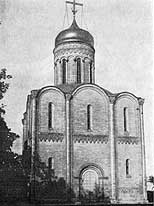| Виртуальный Владимир » Город Владимир » Old Russian Towns » Vladimir » Historic buildings » Monastery of the Nativity |
 ...
... Golden Gates
Golden Gates Panorama of the town and surrounding countryside from Kozlov Val
Panorama of the town and surrounding countryside from Kozlov Val Church of St.Nicholas
Church of St.Nicholas Monastery of the Ascension
Monastery of the Ascension Cherches of Our Saviouer and St.Nicholas
Cherches of Our Saviouer and St.Nicholas Church of St.George
Church of St.George Cathedral of the Assumption
Cathedral of the Assumption Citadel
Citadel View of the town from the edge of Vladimir Monomachs fortress
View of the town from the edge of Vladimir Monomachs fortress Cathedral of St. Dmitri
Cathedral of St. Dmitri Monastery of the Nativity
Monastery of the Nativity Church of the Assumption
Church of the Assumption Northern edge of the town
Northern edge of the town Assumption Cathedral
Assumption Cathedral Church of St. Nicetas
Church of St. Nicetas Let us now leave the Cathedral of St. Dmitri and climb up the steep hill on its south side formed from the earth which was dug out to lay the foundations of the Provincial Administration building at the end of the eighteenth century. We are now standing at a break in the town heights, with the broad sweep of the Klyazma water-meadows and forests in front of us. Only Kiev and Nizhny Novgorod could rival ancient Vladimir in their magnificent elevated sites and the impressive beauty of the surrounding countryside. On the right we can see the white stone walls and golden dome of the Cathedral of the Assumption through the green of the trees. On the left, following the curve of the hill, are the white walls of the old Monastery of the Nativity erected on the Middle Town's earth ramparts at the beginning of the eighteenth century which provide a picturesque frame for its southeast corner.
Let us now leave the Cathedral of St. Dmitri and climb up the steep hill on its south side formed from the earth which was dug out to lay the foundations of the Provincial Administration building at the end of the eighteenth century. We are now standing at a break in the town heights, with the broad sweep of the Klyazma water-meadows and forests in front of us. Only Kiev and Nizhny Novgorod could rival ancient Vladimir in their magnificent elevated sites and the impressive beauty of the surrounding countryside. On the right we can see the white stone walls and golden dome of the Cathedral of the Assumption through the green of the trees. On the left, following the curve of the hill, are the white walls of the old Monastery of the Nativity erected on the Middle Town's earth ramparts at the beginning of the eighteenth century which provide a picturesque frame for its southeast corner.
Up to the middle of the last century the stone Cathedral of the Nativity, built almost at the same time as the Cathedral of St. Dmitri in 1192-1195 and considerably disfigured by subsequent alterations, stood on this spot. Like the cathedral it was linked with the buildings of the abbot's residence, and appears to have had galleries and staircase towers leading to the choir-gallery and built of fine brick, which began to be used again at the end of the twelfth century. Prince Alexander Nevsky who routed the Livonian Knights at the famous battle on the ice of Lake Chudskoye was buried in the Cathedral of the Nativity in 1263. In his funeral oration over the Prince's dead body the Metropolitan Kirill said: "The sun of the Russian land has set."
 Between 1859-1864 the cathedral was "restored" or, to be more precise, taken down and re-built. During the process the local architects studied the old building with great care and constructed a new cathedral which was an exact copy of the original one.
Between 1859-1864 the cathedral was "restored" or, to be more precise, taken down and re-built. During the process the local architects studied the old building with great care and constructed a new cathedral which was an exact copy of the original one.
The general plan of the cathedral, four pillars supporting a single dome, was similar to that of the Cathedral of St. Dmitri. It differed radically from the latter, however, in its extremely severe exterior. The broad outer walls were almost completely void of any ornament and their narrow slit windows had the appearance of fortification loop-holes. The band of blind arcading was replaced by a dull, spiky narrow band of triangular points set downwards. Carving was allowed only on the archi-volts of the portals and the capitals.
This copy of the old building (no longer extant) is important because it shows that two sharply divergent tendencies had appeared in Vladimir architecture by the end of the twelfth century. One was the clerical, monastic style, illustrated by the Cathedral of the Assumption of 1185-1189 and the cathedral of the Monastery of the Nativity, with their severe, ascetic lines and absence of sumptuous, varied carving, which the church had obviously condemned as vain and sinful because of its resemblance to the carved idols of pagan times not so long past. The other is represented by the Cathedral of St. Dmitri with its splendidly impressive architectural lines and rich carving in which the religious motif is lost in a fantastic world of strange animals and plants. This tendency was obviously secular in character, reflecting the taste of the ordinary people with their love of richly decorated buildings, artistic inventiveness and fantastic subjects, as well as the artistic preferences of the feudal nobility. As we shall see later in Suzdal and Yuryev-Polskoi, it was the latter tendency that prevailed.
A beautiful tent-shaped bell-tower was built alongside the Cathedral of the Nativity in 1654 with splendidly finished tiers of pillars. Together with the cathedral it formed an important unit in the row of buildings that made up the town's southern aspect.
Let us now proceed along the walls of the Monastery of the Nativity and once more admire the excellent view. The built-up slopes of the Decayed Town, the eastern part of the old town of Vladimir, have now come into sight behind the corner of the walls, with the seventeenth-
century Church of the Assumption of Our Lady rising above the buildings and trees.
In order to get to the church we shall turn onto the main street. The old wooden Ivan Gates of the Middle Town once stood opposite the corner of the monastery wall. Further on, in Proletarskaya Street, there are traces of the town's ancient fortifications - the earth ramparts and deep moat dating back to 1108.
Not far away, round the corner of the wall is the large monastery building known as the Bishop's House (Arkhiyereisky Dom). Its left, eastern side was once adjoined by the old Holy Gates (Svyatiye Vorota) which have now been replaced by other buildings. Their arch had a remarkable twelfth-century fresco of the Last Judgment very similar to the one in the Cathedral of the Assumption.
Proceeding through the Decayed Town along the Street of the Third International we reach a large building which was formerly a seminary. This spot used to be the centre of the old posad and there were several wooden churches round the small square, whose tall outlines must have provided a sharp contrast to the low, huddled wooden houses. The wooden churches were gradually replaced by stone ones in the seventeenth and eighteenth centuries. Luckily the most beautiful of these stone churches has survived.
Оставить комментарий:



 Виртуальный Владимир
Виртуальный Владимир Область
Область Панорамы города
Панорамы города Организации
Организации Улицы и дома
Улицы и дома Добавить организацию
Добавить организацию О городе
О городе










